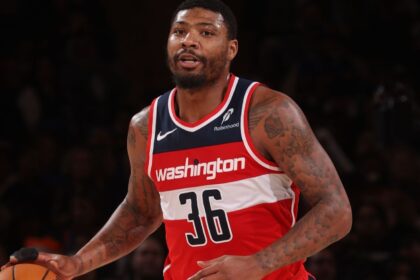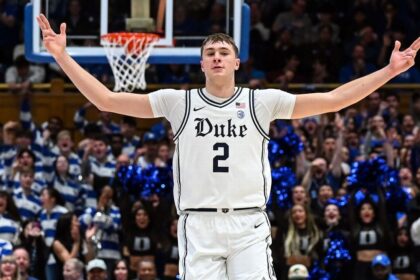New Dynasty in the NBA? The Oklahoma City Thunder and the Mirror of the Golden State Warriors
The most outstanding team in the West is on the rise. Although this franchise hasn’t won an NBA title since the 1970s, led by a 26-year-old point guard fresh off his first MVP trophy, they were on the verge of winning 70 games, finished with a double-digit point differential, and conquered the Western Conference Finals in five games.
We are talking, of course, about the Golden State Warriors of the 2014-15 season, who a decade ago reached their first of five consecutive Finals. But, curiously, the same characteristics apply to the Oklahoma City Thunder of the 2024-25 season, who advanced to the Finals with a decisive 124-94 victory over the Minnesota Timberwolves on Wednesday.
The Thunder are not just another finalist; they are a historically great team that mirrors the Warriors from a decade ago, due to a series of striking similarities between both teams.
In the mid-2010s, no one would have reasonably expected the Warriors, who until that point hadn’t reached the conference finals in the Stephen Curry era, to become the defining team of the decade, but they fought their way through repeated Finals appearances. Similarly, the Thunder hadn’t reached the conference finals in the first half of the 2020s, but they are poised to dominate the rest of the decade and, perhaps, build their own comparable dynasty.
The similarities begin with the demographics of both teams. The 2015 Warriors are the youngest champion team since 1980, with an average team age (weighted by playoff minutes) of 26.4 years. However, the Thunder are even younger, at 24.7 years old.
That youth includes the top scorers from both teams, who are at the same point in their careers. Curry was 26 in 2014-15, just like Shai Gilgeous-Alexander is now. Curry had a 63.8% true shooting percentage on his way to his first MVP a decade ago, while the new MVP Gilgeous-Alexander had a 63.7% this season. (Curry’s 2015 season is still, surprisingly, the most recent MVP campaign that ended in a championship, and SGA has the opportunity to join him in that feat).His teammates are also familiar. Klay Thompson was a 24-year-old two-way star who was part of his first All-NBA third team when the Warriors embarked on their first title run. Jalen Williams is a 23-year-old two-way star who received his first All-NBA third team nomination this year. Draymond Green was a 24-year-old position player from the Midwest who received All-Defensive first team honors. Chet Holmgren is a 22-year-old unicorn from the Midwest who led the league in rim defense and would have been a candidate for All-Defensive recognition if he had been eligible.
But wait, there’s more. Andre Iguodala was a 31-year-old defender who elevated the Warriors when he came off the bench. Alex Caruso is the same for the Thunder, only a year younger. Iguodala earned Finals MVP honors that season. Could Caruso follow his example?
Andrew Bogut was a defensively solid foreign center who started games, but didn’t always finish them, averaging 23 minutes in Golden State’s playoff run. Isaiah Hartenstein is practically the same, with 24 minutes instead of 23.
Both teams also made a crucial offense-for-defense swap while building their rosters. The timelines don’t perfectly align, but the Warriors traded a talented guard, Monta Ellis, because he was a worse playmaker than Curry, and a star defender (Bogut) fit the team better. Similarly, the Thunder traded a talented guard, Josh Giddey, because he wasn’t as good as Gilgeous-Alexander, and a star defender (Caruso) made more sense for their rotation.
Golden State and Oklahoma City also traveled similar paths through the playoffs, heading to the Finals, even when critics doubted their ability to translate the tremendous success of the regular season into the postseason. Remember all the discussion a decade ago about how a team focused on three-pointers like the Warriors couldn’t win in the playoffs? It sounded a lot like this year’s narrative about how opponents didn’t “fear” the Thunder because they hadn’t won the title before.
Both the 2015 Warriors and the 2025 Thunder swept their number 8 seed opponent in the first round, with a big comeback win in the third game: Golden State overcame a 20-point deficit in the final quarter in New Orleans, with Curry’s three-pointer to tie the game over Anthony Davis as the highlight of the comeback, while Oklahoma City overcame a 29-point deficit in Memphis.
Then, both teams had to survive a test of courage against a veteran and playoff-tested team in the second round, after falling 2-1 in the series. The Warriors rallied against the Memphis Grizzlies to win in six games, while the Thunder used multiple fourth-quarter comebacks to beat the Denver Nuggets in seven.
Both teams used a new defensive resource: the Warriors had Bogut “guard” non-shooter Tony Allen, and the Thunder put Caruso on center Nikola Jokic, to pave the way to victory.
And in the conference finals, against a team led by a rising star ([James Harden] James Harden of the Houston Rockets then and [Anthony Edwards] Anthony Edwards of the Minnesota Timberwolves now) and a multiple-time Defensive Player of the Year at center (Dwight Howard then and Rudy Gobert now), the Thunder and the Warriors won in five.
Perhaps the two teams followed analogous trajectories due to their similar statistical profiles. The Warriors are remembered for their offensive brilliance, as the avatars of the three-point revolution, but their first championship team was actually better on the other end. Golden State ranked first in defensive rating and second in offense, similar to the Thunder, who ranked first in defensive rating and third in offense this season.
Both teams allowed significantly more free throws than they attempted, but led the league in points per turnover and were able to break their opponents with sudden bursts of points.
Perhaps the most crucial connection in the big picture between the two dominant teams is that the best was yet to come for Golden State, which may also be true for Oklahoma City. In retrospect, it’s easy to identify the Warriors’ magical 2014-15 season as only the beginning of something special, rather than its peak: in fact, they had a better point differential in 2015-16 and 2016-17 and won several more titles after the first.
Similarly, it’s not difficult to imagine an even better season for the Thunder in the near future, given the youth of the group and the flexibility of the roster. The Thunder could also benefit from better luck with injuries. They won at a 70-win pace when at least one of Holmgren and Hartenstein was available, but they lost both centers for a couple of less successful stretches this season.
After all, the Thunder have already set the NBA record for point differential this season. With another year of development, is it that hard to imagine them chasing the regular season wins record (73) next year, considering the Warriors set the mark the year after their first Finals run?
However, two main obstacles could stand in the way of an Oklahoma City dynasty rivaling the Warriors’ of the last decade. First, the NBA’s new “apron” rules could cause a premature breakup of the Thunder’s elite depth.
To keep their championship template together long-term, the Warriors led the NBA in payroll in 2017-18 and 2018-19, with a combined total of $86 million in luxury tax payments in those two seasons. A decade later, it’s not just a question of whether Oklahoma City’s owners will approve such extravagant spending, but whether additional “apron” restrictions will prevent that possibility altogether.
Secondly, the Warriors extended their streak by signing Kevin Durant in his prime.
It’s fun to speculate how their dynasty might have unfolded if Durant had signed with another team or stayed with the Thunder in 2016. It’s not that the Warriors would have collapsed without him: they had just won 73 games and probably would have won the title if it weren’t for Green’s suspension in the Finals.
But Cleveland arguably had the best team of LeBron James’ second era in 2017, and Western Conference threats like the San Antonio Spurs and the Rockets were on the rise. Golden State probably wouldn’t have reached five straight Finals without Durant.
Unless the Thunder win the title and trade for Giannis Antetokounmpo this summer, it’s irrational to imagine a comparable move for Oklahoma City. In itself, that might be reason enough to doubt the Thunder’s ability to dominate the rest of the 2020s, compared to Golden State in the 2010s.
But the Thunder have an advantage the Warriors didn’t. Aside from Durant, Golden State didn’t really add to its core once it started winning. Of the top 10 Warriors in total playoff minutes during their five-year run, eight were already on the team when the 2014-15 season began. The only exceptions were Durant and Kevon Looney, who joined the club in the summer of 2016 via free agency and the draft, respectively.
Golden State barely utilized the draft after adding Curry, Thompson, Green, and Harrison Barnes from 2009 to 2012. Due to a series of trades, the Warriors only made three selections in the six drafts from 2013 to 2018. Looney worked out, but Damian Jones and Jacob Evans did not. They also traded Jordan Bell, Patrick McCaw, and Nemanja Nedovic on draft night, none of whom became long-term contributors.
Unlike the Warriors, the Thunder have more draft picks than they can actually use, including all of their own picks and future first-round picks or swaps from the Miami Heat, LA Clippers, Rockets, Philadelphia 76ers, Utah Jazz, Nuggets, and Dallas Mavericks. That stash means more opportunities for Oklahoma City to build around its young “big three”, which will be necessary, given the salary cap complications that hinder deep, star-studded teams in the modern NBA.
The notion of a dynasty in Oklahoma City still seems distant, given that they haven’t yet won their first title. But the Thunder are favored to do so, and if they win, they will be in a better position to extend their reign than any recent champion.
After a whole column of similarities, that context might be the biggest difference between the 2015 Warriors and the 2025 Thunder. Golden State appeared in the spotlight as the latest edition of a long lineage of NBA dynasties. From 1999 to 2014, every Finals featured the Lakers, Spurs, or Heat, and repeat titles were the norm rather than the exception.
In comparison, as Oklahoma City rises on the competitive scale, the NBA is guaranteed its seventh different champion in the last seven years. No reigning champion has advanced beyond the second round since the 2018-19 Warriors.
But the stage is set for the next great NBA dynasty. The Thunder’s blueprint is clear, as they follow the Warriors’ model a decade later. They’ve assembled a talented “big three” with the right supporting cast. They’ve survived the necessary playoff tests. And they’re poised to define the 2020s, much as the Warriors became synonymous with the NBA in the 2010s.









